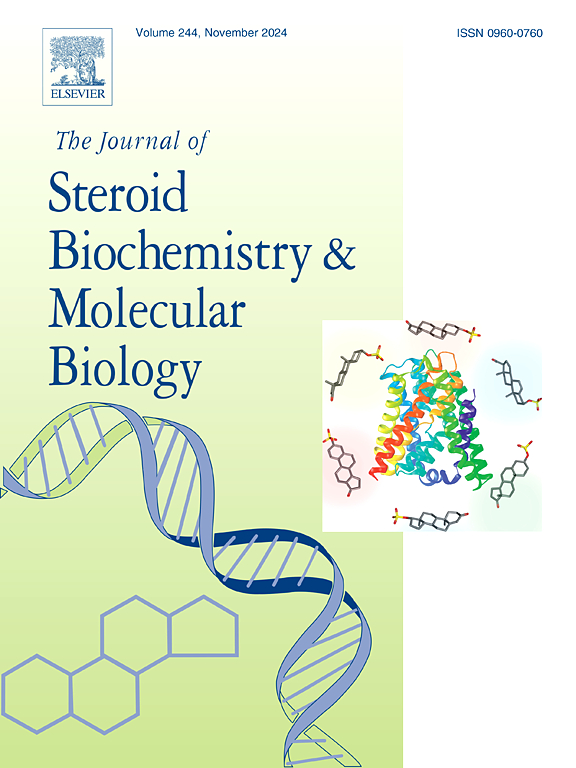Biological gender difference of bile acid metabolism in susceptibility to cholelithiasis in patients with nonalcoholic fatty liver disease
IF 2.5
2区 生物学
Q3 BIOCHEMISTRY & MOLECULAR BIOLOGY
Journal of Steroid Biochemistry and Molecular Biology
Pub Date : 2025-06-09
DOI:10.1016/j.jsbmb.2025.106812
引用次数: 0
Abstract
The incidence of gallstone disease (GSD) is often higher in female patients with nonalcoholic fatty liver disease (NAFLD) compared to their male counterparts; however, the underlying mechanisms remain unclear. This cross-sectional study aimed to investigate gender differences in susceptibility to GSD with a focus on the specificity of bile acid (BA) metabolism, while also considering the reciprocal influence between gut bacteria and BAs. A total of 16 female and 36 male NAFLD patients, identified as having a high risk of GSD, were included in the study. Serum and fecal BA profiles were analyzed, along with a correlation analysis of gut microbiota composition. Gender-specific divergence in hydrophobic BAs distribution was observed, with females exhibiting significantly higher serum retention. The concentrations of serum glycolithocholic acid, isolithocholic acid, and 12-ketolithocholic acid, as well as fecal lithocholic acid, were significantly higher in females than in males. Conversely, the levels of serum hyodeoxycholic acid, fecal 7-ketolithocholic acid (7-keto-LCA), chenodeoxycholic acid, glycocholic acid, and ursodeoxycholic acid were significantly lower in females. Additionally, the total abundance of Fusobacterium and Escherichia-Shigella in the gut microbiota was elevated in females. A statistically significant inverse correlation was observed in females between reduced fecal 7-keto-LCA levels and an increased abundance of butyrate-producing bacterial communities. Overall, BAs and gut microbiota exhibit gender dimorphism in NAFLD patients, which may be linked to the increased risk of secondary GSD in women.
非酒精性脂肪肝患者胆汁酸代谢对胆石症易感性的生物学性别差异
非酒精性脂肪性肝病(NAFLD)女性患者的胆石病(GSD)发生率通常高于男性患者;然而,潜在的机制仍不清楚。本横断面研究旨在探讨GSD易感性的性别差异,重点关注胆汁酸(BA)代谢的特异性,同时考虑肠道细菌和BA之间的相互影响。共有16名女性和36名男性NAFLD患者被确定为GSD的高风险,被纳入研究。分析血清和粪便BA谱,以及肠道微生物群组成的相关性分析。观察到疏水BAs分布的性别差异,女性表现出明显更高的血清保留率。血清糖石胆酸、异石胆酸、12-酮石胆酸及粪便石胆酸浓度,女性显著高于男性。相反,女性血清羟脱氧胆酸、粪便7-酮石胆酸(7-keto-LCA)、鹅去氧胆酸、糖胆酸和熊去氧胆酸水平显著降低。此外,雌性肠道菌群中梭杆菌和志贺氏杆菌的总丰度升高。在雌性中,粪便7-酮- lca水平的降低与丁酸生成细菌群落丰度的增加之间存在统计学上显著的负相关。总的来说,BAs和肠道微生物群在NAFLD患者中表现出性别二态性,这可能与女性继发性GSD的风险增加有关。
本文章由计算机程序翻译,如有差异,请以英文原文为准。
求助全文
约1分钟内获得全文
求助全文
来源期刊
CiteScore
8.60
自引率
2.40%
发文量
113
审稿时长
46 days
期刊介绍:
The Journal of Steroid Biochemistry and Molecular Biology is devoted to new experimental and theoretical developments in areas related to steroids including vitamin D, lipids and their metabolomics. The Journal publishes a variety of contributions, including original articles, general and focused reviews, and rapid communications (brief articles of particular interest and clear novelty). Selected cutting-edge topics will be addressed in Special Issues managed by Guest Editors. Special Issues will contain both commissioned reviews and original research papers to provide comprehensive coverage of specific topics, and all submissions will undergo rigorous peer-review prior to publication.

 求助内容:
求助内容: 应助结果提醒方式:
应助结果提醒方式:


